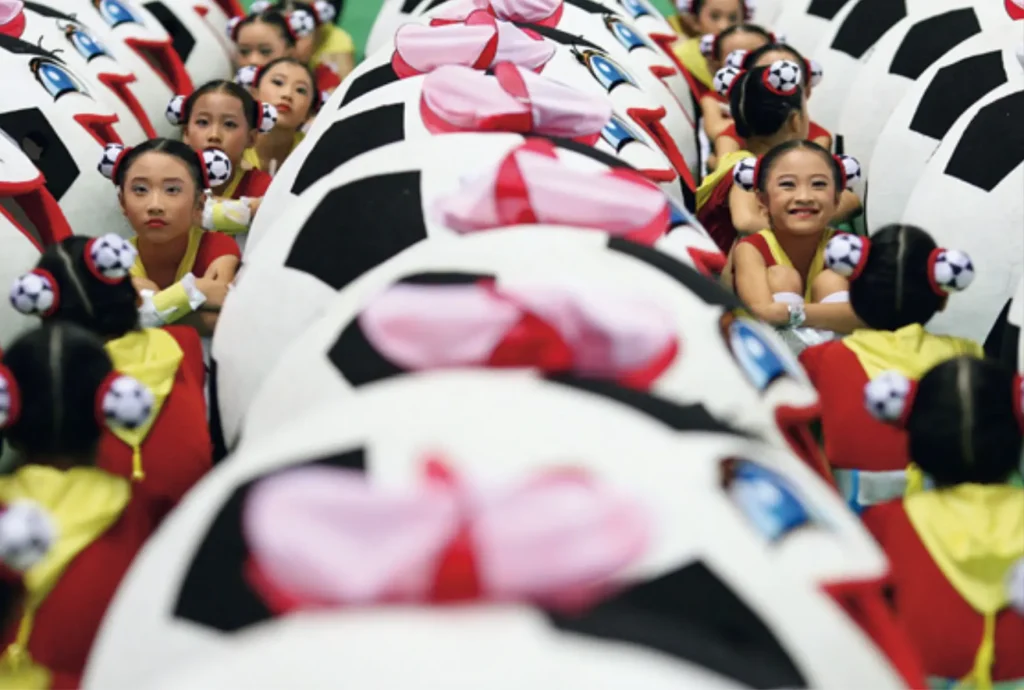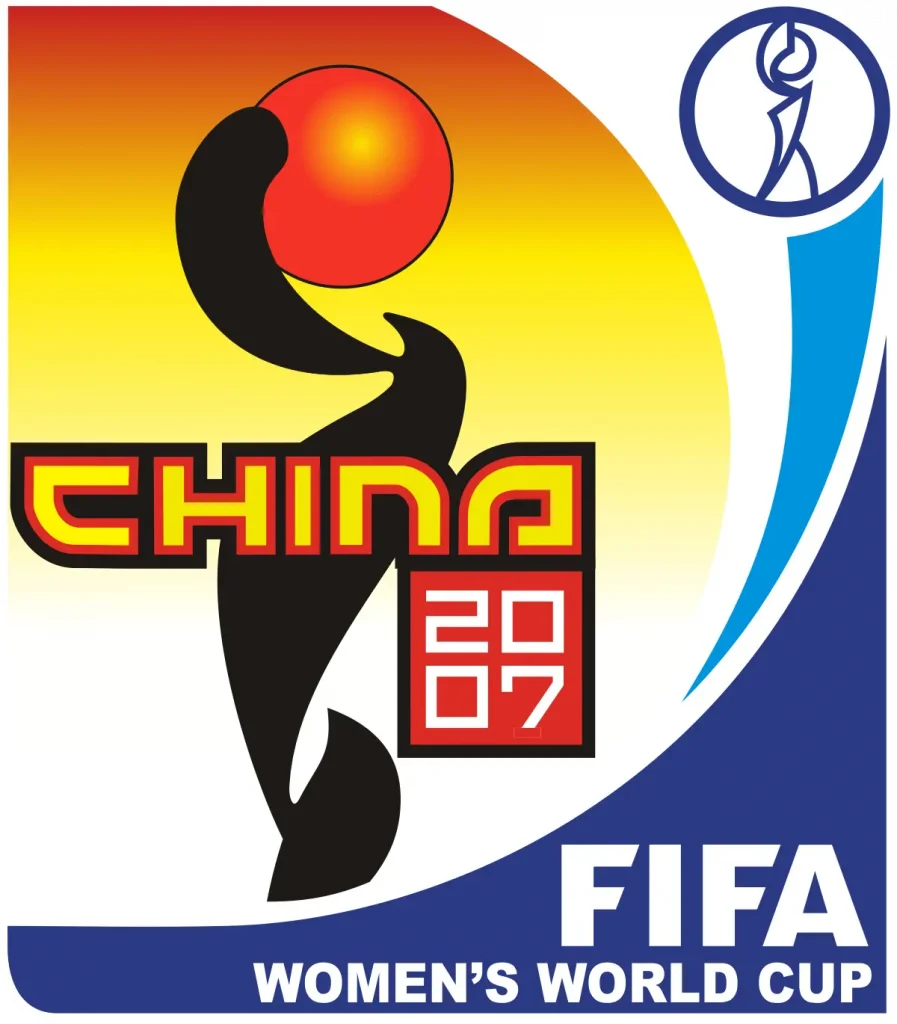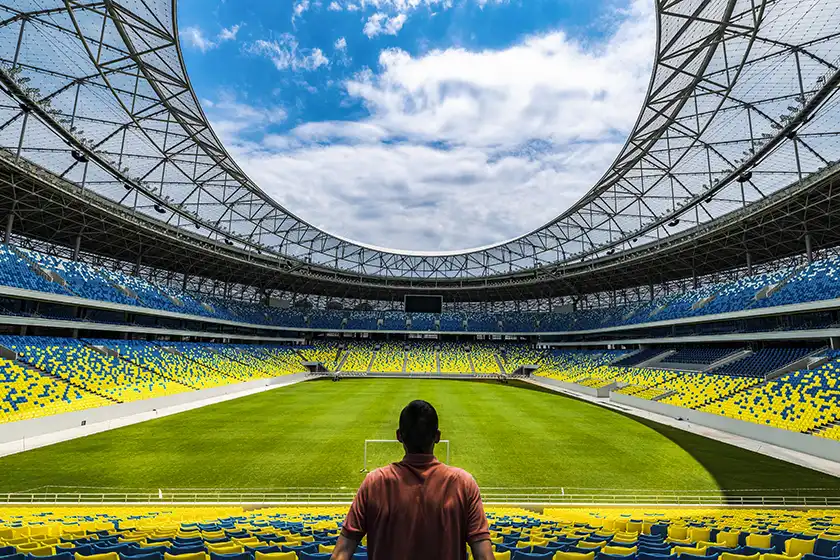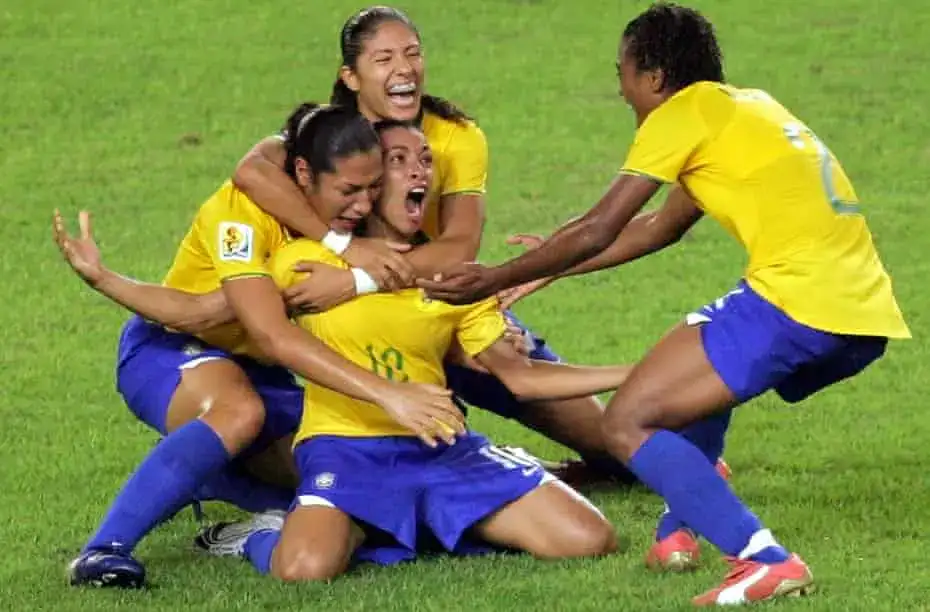China hosted the 2007 Women’s World Cup Final on 30 September 2007, which was won by Germany, who defeated Brazil 2–0.
The defending champions of the 2003 FIFA Women’s World Cup final played the Brazil national team who had never won a major world title or even reached the finals of a FIFA Women’s World Cup. It was the first time a European and South American countries met in the Women’s World Cup final.
The Host Country Of 2007 Women’s World Cup
It is fitting that China, the inaugural 1991 FIFA Women’s World Cup hosts, have been chosen to stage the women’s World Cup event once again in 2007. The next edition of the prominent women’s tournament was staged over five cities across East Asia’s largest country, where the game’s football origins have been dated back to the second century.
It was recently argued that a form of soccer, or “cuju,” as it was named, originated in the Shandong Province of Linzi during the West Han Dynasty. A primitive version of soccer existed in China centuries before it was modified and given rules by English scholars to become association football, as it is known today, in the mid-18th century.
But the game’s inventors and pioneers found themselves, pupils, to the modern game when it was introduced back to their territory around 1900. However, the national football association was not founded until 1924, and seven years later, the CFA became affiliated with FIFA.
China has always been fully aware of its lagging behind the front-runners. But the game’s birth nation wasted no time in recalling those early golden days or bemoaning the application of a new set of rules. Yet they had consistently made considerable efforts to develop the game on home soil and were able to gain back some of the ground lost when the country was transformed under an open policy in 1978.
China’s Women’s World Cup Progress
The first breakthrough came when China hosted the inaugural FIFA U-17 World Championship in 1985, and the locals made the most of the occasion by reaching the last eight in the competition. But that achievement was overshadowed by the startling rise of the women’s team, who marked their place among the world’s elite two decades ago.
Following their victory over Japan in the 1986 AFC Women’s Championship final, China successfully defended the championship for six consecutive years, cementing their status as a dominant power. Affectionately named the Steel Roses, the team won the silver medal in the 1996 Atlanta Olympic Games final, losing to the United States.
However, the same rivals cruelly denied them again three years later in the final of the FIFA Women’s World Cup USA 2003 when a Brandy Chastain spot-kick handed the hosts victory in a dramatic penalty shoot-out.
Into the new millennium, and China’s progress continued. The women, apart from a disappointing campaign in USA 2003 and a shock 8-0 defeat to the Germany women’s national football team in the 2004 Athens Olympics, continued to progress and finished runners-up in the 2004 FIFA U-19 Women Championship in Thailand. Meanwhile, reaching the FIFA World Cup finals in 2002 Korea/Japan for the first time was a landmark moment for the men’s senior side.
Previous Records In FIFA Women’s World Cups
Since hosting the first edition of the FIFA Women’s World Cup in 1991, China has been a competitive power in the past three tournaments in 1995, 1999, and 2003. The second-place finish at 1999 USA marked the pinnacle of their past results, but the 2003 tournament saw an aging team fail to progress to the last four following a 1-0 quarter-final defeat to Canada.
Did You Know?
- The People’s Republic of China has a population of over 1.3 billion – the most populated nation in the world.
- Beijing’s capital city is the country’s cultural, political, and educational center.
- One of the world’s four oldest civilized nations alongside Greece, Egypt, and India, China’s first recognized dynasty dates back to 2,200 years B.C.
- The nation has 56 ethnic groups, with Han the largest, forming the majority of the country’s population.
- Mandarin, or Pu Tong Hua, the official dialect of the Chinese language, is the most commonly spoken language.
- A simplified form of Chinese is used in mainland China while traditional Chinese is still used by people in Chinese Taipei, Hong Kong, Macau, and many nationals overseas.
- Traditionally Buddhism, Taoism, and Confucianism are the three principal religions in the country, with Muslim and Christianity also prevalent.
- Location Of 2007 Women’s World Cup
- China is located in the east part of Asia, stretching 5,000 kilometers from east at Heilongjiang River to the west at the Pamir Mountains in Central Asia and 4,000 kilometers from North at Heilongjiang Province to the south at Hainan Island, then another 1,450 kilometers’ south by sea to Zengmu Shoal.
- Shanghai hosted the 2007 Women’s World Cup Final. It is the largest city in China by population.
- It shares borders with Mongolia and Russia in the north, with Afghanistan, Tajikistan, Kyrgyzstan, Kazakhstan in the west, with India, Pakistan, Nepal, Bhutan, Myanmar in the south, and Korea DPR in the east.
Geography Of 2007 FIFA World Cup Hosts
In geographic terms, China is the world’s third-largest country with a surface of 9,596,960 km2. The Qingzang plateau is situated 4,000 meters above sea level and is thus named “the roof to the world” in Tibet. The country’s two longest rivers, the Changjiang (also known as the Yangtze river) and the Huang He, run through the center of the topography before reaching the sea in the east.
In China, most of the year is moderately warm, but complex weather patterns range from cold and temperate in the north to warm and humid in the south. Precipitation varies regionally; temperatures range from minus 30°C in the North in January to 28°C in the south in July. Wet monsoons characterize summer months, while dry monsoons occur during the winter.
2007 Women’s World Cup Stadiums
Chengdu Sports Center Stadium
Built in 1991, the Chengdu Stadium was once home to the Sichuan provincial team. The city was referred to often as the “gold medal city” because of the enthusiastic support usually offered by the enormous crowds that would invariably turn up at the ground. The enthusiasm of the Sichuan fans is famous throughout China, and, as a result, the women’s national teams maintain excellent records when playing there.
The stadium has 38,269 seats and easily enough VIP seats and press spots to host a major FIFA final. The stadium is conveniently located in the city’s heart, 15 kilometers from Shuangliu International Airport. Six group matches were played in the Chengdu Sports Center Stadium.
Hangzhou Dragon Stadium
Despite their status as newcomers on the Chinese domestic soccer scene, Zhejiang Lucheng can be proud of the first-class facilities and infrastructure in place at their towering home stadium. Built in 2000, the Hangzhou Dragon Stadium draws some of the largest crowds in all of China and boasts a significant 52,672 seats.
In addition, the Hangzhou Xiaoshan Airport is just 35 kilometers away and only five kilometers from the city center. The ground’s playing pitch is 105 meters long and 68 meters wide. Seven matches, including six group-stage meetings and one semi-final, were played at the Hangzhou Dragon Stadium.
Shanghai Hongkou Soccer Stadium
Shanghai Hongkou Soccer Stadium is one of China’s largest and most modern stadiums. The 31,000-seater is home to club side Shanghai Shenhua and boasts many VIP seats, skyboxes and amply covers FIFA’s requirements for press seating at a major world final. Before the construction of the Shanghai Stadium in 1998, Hongkou was the most prominent sports arena in the city, hosting major international competitions such as the Shanghai Invitational and the East Asian Games.
Hongkou is conveniently located in Shanghai’s city center, about 45 minutes (40km) from the Pudong International Airport. The pitch at the Hongkou is 105 meters long by 68 meters wide. Four group matches, two quarter-finals, the third-place play-off, and the Grand final were played at the Shanghai Hongkou Soccer Stadium.
Tianjin Olympic Center Stadium
Construction work for the Tianjin Olympics Center Stadium was completed in March 2007. With a capacity of 60,000, the hulking ground accurately represents the city’s strong desire to host the 2007 Women’s World Cup and an ambition to raise the profile of soccer at all levels in China.
It will boast enough VIP seats, places for the media, seats for the disabled, and is just 30km away from the Tianjin Binhai International Airport. Five matches, including two group matches, Two quarter-finals, and one semi-final, were staged at the Tianjin Olympic Center Stadium.
Wuhan Sports Center Stadium
One of China’s finest stadiums, the Wuhan Sports Center, was built in 2002 for the 2007 Women’s World Cup. After the SARS outbreak, it was moved from China to the United States. On 27 January 2003, China played the United States at the ground during the Women’s Four-Nation Invitational Tournament.
Players from both sides expressed their satisfaction with the quality of the pitch. FIFA officials have compared the stadium favorably with Japanese and Korean grounds that played host to the world at the 2002 FIFA World Cup. It has 52,357 seats, great VIP seats, spots for the disabled, skyboxes, and a large number of press seats.
The stadium is conveniently located just 30 minutes (30km) from the Tianhe Airport. The pitch is 105 meters long by 68 meters wide. Four group matches and two quarter-finals were played at the Wuhan Sports Center Stadium.
2007 Women’s World Cup Finalist
Brazil
Ever since the early days of South American women’s soccer, Brazil has worked hard to earn a place amongst the world’s elite. And just like their counterparts in the men’s game, they have constantly wowed spectators across the globe with their entertaining, skillful soccer.
In the past 20 years, only the Auriverde have appeared at every FIFA Women’s World Cup. Even so, the Canarinha would have to wait until the 1999 tournament in the USA to leave their mark. In 1991 and 1995, Brazil women’s World Cup teams failed to make it out of the group stages but took third place with a deserved performance in North America.

The next challenge for Jorge Barcelos’ Selecao is the 2007 Women’s World Cup. Under something of a cloud after their qualification campaign in Argentina, the months leading up to the FIFA Women’s World cup was a testing time for Barcelos’ talented charges.
Brazil lost its first qualifying game in the history of the South American championship. However, the Verdeamarelas had won the four previous continental titles before that decisive reverse, scoring 173 goals while racking up 22 wins, conceding just nine times along the way.
One reason behind this uncharacteristic slip-up could have been the absence of genuine world-class football stars Marta and Katia, as well as the lack of experience in Barcelos’ young squad.
Nevertheless, it must be remembered that the Auriverde campaign still had more than its fair share of high points, including a highly respectable 30 goals scored and a miserly four conceded. Another positive was the emergence of Cristiane Roseira, whose 12 goals propelled her to the top of the scorers’ charts.
Brazil’s Albiceleste, frustrated by losing their throne to deadly rivals, make their way to China, determined to restore the balance and repair their broken pride while in pursuit of World Cup finals victory.
Qualifying
November’s South American qualifying tournament for China 2007, held in the Argentine coastal city of Mar del Plata, was the first time the Selecao booked their place at the 2007 Women’s World Cup without taking the continental crown. Instead, that honor went to the hosts, who took great pleasure in ending the Auriverdes’ bid for a fifth consecutive South American success.
Coach Jorge Barcelos squad selection relied heavily on the U-20 women’s national team that performed so admirably at Russia 2006, where Marta and Katia had also been absent. After boldly proclaiming beforehand that “our goal is to win the tournament and seal our place in China,” the Canarinha coach was forced to settle for second.
In the first phase of qualifying, Barcelos’ charges had dominated Paraguay, Peru, Bolivia, and Venezuela, taking maximum points from Group B. Brazil’s streak continued in the final round, as Paraguay and Uruguay each went down by 6-0 scores to guarantee Brazil’s place in China. All the signs pointed to yet another yellow-and-gold success going into the title-deciding final match with Argentina, only for the plucky Albicelestes to pull off a deserved 2-0 win.
Brazilian Coach
Current coach Jorge Barcelos was once a player himself, the highlight of his brief career being a two-year spell in Japanese amateur soccer between 1993 and 1994. Having hung up his boots, Barcelos became a coach and had great success. In 2005, the promising young tactician earned a place on the Brazilian Football Confederation’s (CBF) technical committee after gaining experience in management in Japan.
Taking over from Luis Antonio Ferreira as head coach of Brazil’s U-20 team in March 2006, Barcelos led the team to the FIFA U-20 Women’s World Cup Championships in Russia in 2006. “I’ve always dreamed of working at the very highest level of the women’s game,” he said at the time.
In the event, his Verdeamarela disciples did him proud over on Russian soil, beating traditional heavyweights the USA on penalties to finish in third place. The task before strategist coach is now even more extraordinary: to guide Brazil to their first-ever FIFA Women’s World Cup trophy.
Brazil Women’s World Cup History
- Only Brazil has participated in every Women’s World Cup tournament.
- Brazil’s best-ever performance at the FIFA Women’s World Cup came in 1999 in the United States, where the Selecao finished third.
Germany
Germany, the reigning World, and European football champions were hoping to retain their titles at the 2007 Women’s World Cup in China. Silvia Neid’s side has been performing at a consistently high level in recent years, with only the USA, China PR (twice), Norway, and Australia have gotten the better of them.
The German women’s World Cup squad has strength in depth, perhaps unrivaled in the women’s game above and beyond the obvious advantage of possessing world-class talents such as midfielder Renate Lingor and striker Birgit Prinz. That was certainly borne out in the China 2007 World Cup qualifiers, where Germany netted 31 goals in their eight group matches, with no fewer than 12 different players getting their names on the scoresheet.
The women’s national teams certainly have no shortage of forwards, being able to call on the likes of Petra Wimbersky, Conny Pohlers, Sandra Smisek, and Martina Mueller, in addition to Prinz. Playmaker Renate Lingor is ably assisted in midfield by Kerstin Garefrekes, who notched four goals in the qualifying round.
Silke Rottenberg and Nadine Angerer, the reigning champions’ backup goalies, also look strong. This talented shot-stopper would be the first choice between the goals posts for most other women’s national teams. With Kerstin Stegemann and her teammates at the back, Germany only conceded three goals in qualifying. However, that statistic can also be partly attributed to the stature of their group opponents, and the 2007 finals in China were sure to be a different story altogether.
Qualifying
Germany qualified for the 2007 Women’s World Cup China with an unblemished record, winning all eight games in a group that included Russia, Switzerland, the Republic of Ireland, and Scotland. The Germans dominated their opponents national teams technically, tactically, and physically, and rarely allowed themselves to be put under pressure – something their final goal difference of plus-28 bears testimony to. Germany began their campaign by crushing Russia 5-1, nominally their biggest rival, and continued with 4-0 wins over Scotland and Switzerland at home.
The Republic of Ireland provided stiffer resistance, going down 1-0 in Germany before losing the return fixture 3-0 in Dublin. Germany’s 6-0 win in Switzerland was not relatively as easy as the score suggests, with the home side holding the visitors to a single goal for much of the game before running out of steam late on.
Silvia Neid’s side then overran Scotland 5-0 on their territory before wrapping up the campaign with a 3-2 victory away to Russia, where their thoughts may already have been on China as they allowed the hosts back into the match with two late goals. The top scorer for the Germans in qualifying was two-time FIFA Women’s World Player of the Year Birgit Prinz, with eight goals.
Germany Coach
Coach Silvia Neid took over the reins of all the German women’s national teams in July 2005, having been assistant to Tina Theune-Meyer. After leading Germany to victory at the UEFA European Championships in England, the latter stepped down. Before that, Neid was in charge of Germany’s U-19 side, steering them to the world title in Thailand in 2004. She has been on the German Football Association’s coaching staff since 1996.
Neid ranks alongside Doris Fitschen and Martina Voss as Germany’s most successful women’s soccer players. As a player, she made 111 international appearances, winning three UEFA European Championships in 1989, 1991, and 1995. She was also a member of the side that lost in the FIFA Women’s World Cup final. At club level, she won seven German league titles and six cup-winners medals.
With Germany holding both the World and European titles, Neid knows she has a hard act to follow. One of her main aims is to gradually introduce fresh talent into an established line-up while keeping the Germany national team at the very top of women’s soccer.
Germany Tournament Record at FIFA Women’s World Cups
- 4th place at the inaugural FIFA Women’s World Cup in China 1991
- Runners-up at Sweden 1995
- Quarter-finalists at USA 1999
- Winners of USA 2003
The 2007 Women’s World Cup Final
31,000 people came to sell out Hongkou Football Stadium in Shanghai hoping to see an intense spectacle. UEFA representatives Germany, who entered the match with the tournament’s best defensive record having conceded no goals in their five previous games, faced a free-scoring Brazil side which had netted 17 times en route to the decider, including four against fellow title contenders the USA in the semi-finals.
Brazil’s seventeen goals en route to the final were led by striker Marta Vieira da Silva, who scored seven goals, including four against the title-rival United States in the semi-finals. In some ways, it was like a rematch of the 2002 FIFA World Cup Final, except that it was the men’s teams.
Australian referee Tammy Ogston got the proceedings underway. An early volley by Daniela of Brazil struck the post. But it was a scuffed shot from Birgit Prinz that got past Andreia to make it 1-0 to the German Women. Annaike Krahn could have won the match moments later with a header from a corner, but her effort was mere inches off target.
Cristiane burst into the German penalty area on 64 minutes, forcing Linda Bresonik to bring her down. Marta then missed a penalty when Nadine Angerer saved her shot, and the Germans sealed the win with a late goal from Simone Laudehr.
Brazil performed with flair and creativity and posed problems throughout the match. The Brazilian women continued to push for an equalizer and threw everything forward, but the German defense, particularly Ariane Hingst, stood firm.
The 2-0 scoreline was harsh for the team after Simone Laudehr’s header with four minutes remaining sealed the outcome. A closely fought battle between defensive consistency and attacking flair ultimately ended with a victory for the defending champions.
Under the guidance of head coach Silvia Neid, the German juggernaut effectively took Jorge Barcellos’ aces out of the game. In particular, the holders kept a tight reign on their opponents’ linchpin striker Marta, who was unable to get a clear shot on goal or link up effectively with her team-mates.
2007 Women’s World Cup Goal Of The Tournament
The spectacular goal scored by Marta in the semi-final of China 2007 has been voted the World Cup Goal of the Tournament. The Brazilian prodigy, who already won the Adidas Golden Ball and Golden Shoe awards for best women’s player and top scorer at the tournament, can now add the Adidas Golden Shoe award to her collection from her time in the Far East.
The No 10’s goal was not only stunning in its own right, but it came at a pivotal moment in the event. This occurred in the semi-final against the USA on 27 September in Hangzhou. Using her trademark acceleration to sprint into space out on the left, the Umea striker brilliantly flicked the ball back past her marker before ghosting onto it and turning infield towards goal.
After taking out another defender with a delightful shimmy, she released a shot that left Briana Scurry wrong-footed. Marta, whose goal earned her a place on the podium, fought off competition from her teammates Cristiane and Formiga, whose goals against Australia also earned them a podium spot.










